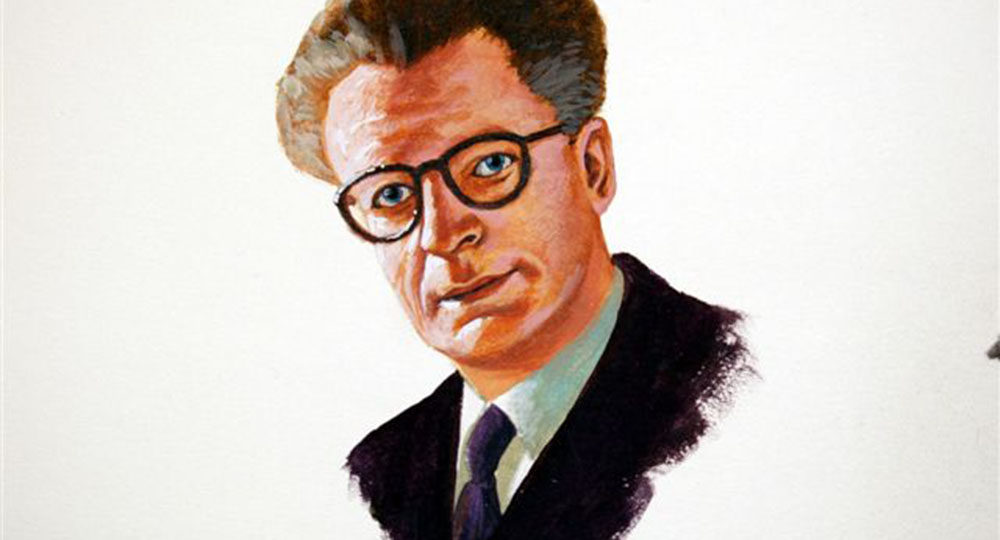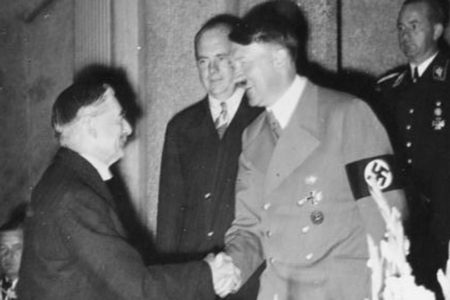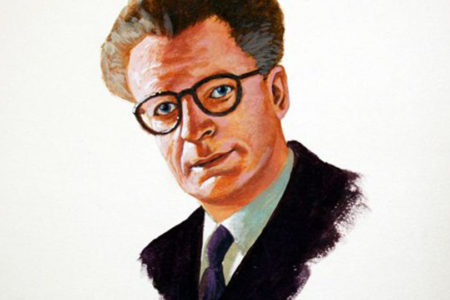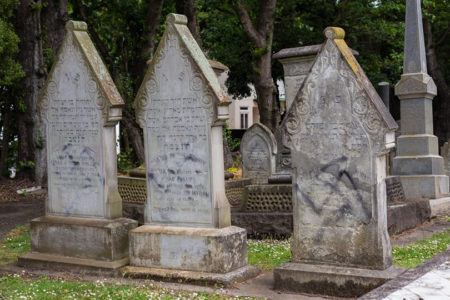Holocaust Revisionism’s Big Deniers
Several years ago I met a World War II veteran who had been with the American armored division that had liberated the labor camps of Austria. Seared into his memory were barracks where the sick and infirm were thrown, one on top of another, and left to die, covered in their own vomit and excrement.
He saw piles of dead bodies waiting to be bulldozed into open pits. His division discovered mass graves, some containing more than 15,000 bodies. He never forgot the scenes of emaciated human beings barely able to walk. So weak were they when the Allies arrived that their cheers were scarcely audible.
With my hand in his vice-like grip, he implored me to do all in my power to keep alive the memory of the crimes against God’s Chosen People. As I listened to his story, I thought it unthinkable that anyone would presume to discredit thousands of eyewitnesses, deny the atrocities of that gruesome era, or attempt to persuade people that the Nazis’ genocide never happened.
Since then, however, the legitimacy of his impassioned plea has become increasingly apparent. Although the majority of reputable historians still look down on Holocaust revisionism as an aberrant dogma propagated by a fringe minority, the view is receiving increasingly more publicity, particularly in the Arab world.
Contending that the Nazis’ systematic extermination of some 6 million Jewish people never happened, Holocaust deniers use fallacious information, unsubstantiated claims, and monotonous repetition to sear their lies into the consciousness of an unsuspecting public. Although claiming to be searching for answers, their true agenda is vastly different.
The Instigators
Paul Rassinier of France (1906–1967) is considered the father of Holocaust “revisionism.” Dismissing the accusations against the Nazis as little more than the tendency of victims to exaggerate, Rassinier suggested the Jewish people brought the genocide on themselves, and he began eroding the foundational facts of the Holocaust. In 1948 he wrote Le Passage de la Ligne (Crossing the Line). Soon several pro-Nazi and anti-Semitic figures in the United States picked up Rassinier’s themes and spearheaded an effort to spread the deception.
By the late 1950s, Austin J. App (1902–1984), an ardent defender of Nazi Germany, emerged as the most notorious Holocaust denier. He not only attempted to disprove the Nazi murder of 6 million Jews, but he also had the audacity to accuse Jewish people of perpetrating a massive hoax on the world. A professor of English literature at the Jesuit University of Scranton in Pennsylvania and later at LaSalle College, App was instrumental in establishing foundational assertions that characterize almost all modern forms of Holocaust denial. Using a confusing and unsubstantiated statistical profile that purportedly defines the demographics of prewar and postwar Europe, App claimed the number of Jewish casualties was exaggerated and that the real victim was Germany, not European Jewry.
Over the next two decades, App’s influence surfaced in numerous ultra-right-wing movements in North America and Europe. In 1969 David Leslie Hoggan anonymously authored The Myth of the Six Million, published by the founder of the neo-Nazi Liberty Lobby, Willis Carto. In 1974 Richard Verrall, leader of the neo-fascist National Front and publisher of the neo-Nazi tabloid, Spearhead, authored a similar booklet titled Did Six Million Really Die?
Wrote Holocaust expert Dr. Deborah E. Lipstadt, “Both these publications consistently mixed truth with fiction,…fabricated quotes, and outright lies with partially correct information.”1
Northwestern University professor, Arthur R. Butz, added a new sophistication to the deception with his book The Hoax of the Twentieth Century: The Case Against the Presumed Extermination of European Jewry. Incorporating extensive footnoting and an impressive bibliography, his book stood in stark contrast to the virulent, poorly written tirades that typified much of denial literature. Using dubious data centering on the supposed mechanical and technological limitations of the equipment at the time, Butz argued that extermination of the Jewish people on the scale commonly acknowledged was not even possible. Despite his far-fetched claims, plus mountains of documentation to the contrary, Butz nevertheless succeeded in providing further momentum and a new level of acceptability to the denial movement.
Manipulating the Media
In the late 1970s, an infrastructure for Holocaust denial began to take shape; and various strands of the movement united under the umbrella of the Los Angeles-based Institute for Historical Review (IHR). Funded by Willis Carto and directed by former National Front officer William David McCalden (also known as Lewis Brandon), IHR established The Journal of Historical Review. Mimicking the format of an academic journal, the publication became the medium disseminating revisionist ideology in intellectual circles.
Endowed with grants and legacies from wealthy supporters, IHR’s influence mushroomed. Leonard Zeskind, research director for the Center for Democratic Renewal, commented on the implication of the spreading influence of IHR in an interview. Speaking of a bequest left to IHR by Jean Farrel Edison, granddaughter of Thomas Edison, he declared, “It [IHR] is getting a $10 million bequest from one of the heirs of Thomas Edison, solely for the purpose of promoting Holocaust denial.”2
In addition, IHR initiated and organized conferences known as International Revisionist Conventions, attracting and coordinating the efforts of Holocaust deniers world-wide. IHR’s primary strategy used mass media to bring Holocaust denial into the mainstream of public debate. Offering $50,000 to anyone able to prove the Nazis gassed Jewish people, it sowed seeds of doubt. When a man named Mel Mermelstein provided affidavits detailing the deaths of his mother, father, brother, and two sisters at Auschwitz-Birkenau, IHR was unquestionably exposed. It refused to pay Mr. Mermelstein the$50,000, and he sued. Although the court ruled that IHR acted fraudulently because it never intended to acknowledge credible evidence or pay the reward, Holocaust deniers accomplished their objective in creating confusion.
In the 1980s the primary proponent of Holocaust denial was Ernst Zundel, a zealous German Nazi who immigrated to Canada in 1958. Known for his ability to create a media sensation, he has been called the P. T. Barnum of Holocaust denial. His printing house, Samisdat Publishers Ltd., is considered one of the largest distributors of Nazi and neo-Nazi propaganda in the world. Two of Samisdat’s best-known publications are The Hitler We Loved and Why and Verrall’s 32-page booklet, Did Six Million Really Die?
In 1984 Zundel stood trial for using Samisdat to incite social and racial intolerance. Although sentenced to 15 months in prison, Zundel won an appeal on procedural grounds and was retried in 1988. At his second trial, Holocaust denier David Irving joined the defense team. Using Butz’s thesis, the defense secured the services of Fred A. Leuchter, a self-proclaimed expert in the functioning of gas chambers. His report claimed it was “chemically and physically impossible” for the Germans to have gassed people on such a grand scale. Credentialed solely with a B.A. in history, the court found Leuchter had “little technical training to equip him to reach his conclusions.”3 “The judge,” wrote Lipstadt, “derided aspects of his methodology as ‘gross speculation’ and dismissed his opinion as being of no greater value than that of an ordinary tourist.”4
Although Leuchter’s testimony was discredited, IHR nonetheless capitalized on the sensational media coverage. Zundel and his supporters would arrive in court sporting bulletproof vests and hard hats bearing the slogan “Freedom of Speech.” They created a virtual circus atmosphere, using the trial to shift public opinion and give the impression it was about free speech.
In March 2005, at age 66, Zundel was deported from Canada as a threat to national security. He awaits trial on hate-crimes charges in Mannheim, Germany. Chanting crowds carrying picket signs manipulated coverage of his deportation to spread his mendacities and portray him as a poor victim of intolerance.
The Holocaust denial movement took a quantum leap forward when it invaded college campuses via the efforts of Bradley Smith in the early 1990s. Recognizing that colleges and universities were fertile soil for sowing the seed of Holocaust denial, Smith began placing low-profile ads in campus newspapers. He admitted, “I don’t want to spend time with adults anymore. I want to go to students. They are superficial. They are empty vessels to be filled.”5
His brief ad invites the curious to a Web site containing the texts of entire books, plus articles and links to sites specializing in Holocaust denial. Committed to creating a debate where there is none, Smith, now 75, uses campus newspapers to his great advantage. If a paper publishes his ad, his message reaches the target. If the paper rejects it, he plays the victim and loudly bewails either the death of free speech or the university ideal of open inquiry and academic freedom. Either way, he generates the publicity he seeks to spread his deception.
In the new millennium, the movement has become increasingly media savvy, choreographing news coverage to its advantage. Using the myth of “balanced reporting,” Holocaust deniers persuade the news media to give them equal billing with the truth, further confusing viewers.
On the day world leaders gathered to dedicate the newly expanded Yad Vashem Holocaust memorial museum in Jerusalem, C-SPAN planned to air a television interview with Deborah Lipstadt, Holocaust scholar at Emory University and author of History on Trial: My Day in Court with David Irving. The book chronicles a libel suit Irving brought against Lipstadt, which resulted in a legal battle that lasted almost five years. Not only did the trial expose the “pseudo scholarship and devious methodology” of the Holocaust denial movement, but Judge Charles Gray found Irving to be a “right-wing pro-Nazi polemicist” who “deliberately misrepresented and manipulated historical evidence.”6
In keeping with its policy on “balanced reporting,” C-SPAN also planned to air a speech by Irving, the foremost spokesman for the Holocaust denial movement. An executive at C-SPAN tried to explain the decision: “You know how important fairness and balance is at C-SPAN….We work very, very hard at this. We ask ourselves, ‘Is there an opposing view of this?’”7 Despite Irving’s overwhelming courtroom defeat, C-SPAN treats his lies as an equally viable viewpoint.
The Truth
Holocaust revisionists claim to be searching for answers, but their true agenda is far different. Ben S. Austin stated it in an article titled “Deniers in Revisionists Clothing”:
Contemporary Holocaust deniers are not revisionists—not even neo-revisionists. They are Deniers. Their motivations stem from their neo-Nazi political goals and their rampant anti-Semitism.8
In the final analysis, Holocaust revisionism is nothing more than poorly camouflaged anti-Semitism. With each passing year the number of eyewitnesses to the Nazis’ horrific genocide diminishes. But their testimony need not die with them. Christians armed with the truth must lead the way in stemming the tide of lies and misinformation about the Holocaust. My friend never forgot what he saw at the end of World War II—and neither should we.
ENDNOTES
- Deborah E. Lipstadt, Denying the Holocaust: The Growing Assault on Truth and Memory (New York: Penguin Books, 1993), 105.
- Kenneth S. Stern, Holocaust Denial (The American Jewish Committee, 1993), 8.
- Lipstadt, 163.
- Ibid., 163.
- “Bradley Smith/The Committee for Open Debate on the Holocaust (CODOH)” <www.adl.org/learn/ext_us/smith_codoh.asp>.
- <www.holocaustdenialontrial.org/images.HTML>.
- “C-SPAN’s Shaky Balance,” March 16, 2005 <www.honestreporting.com/articles/45884734/critiques/C-SPANs_Shaky_Balance.asp>.
- Ben S. Austin, “Deniers in Revisionists Clothing” <www.mtsu.edu/~baustin/revision.htm>.







Going back in the archives and read this article for the first time. Joseph Gerbils (Hitler’s propaganda) person said,
tell a unbelievable lie long enough and people will believe it.
We must remember the truth.
Thank you for the reminder.